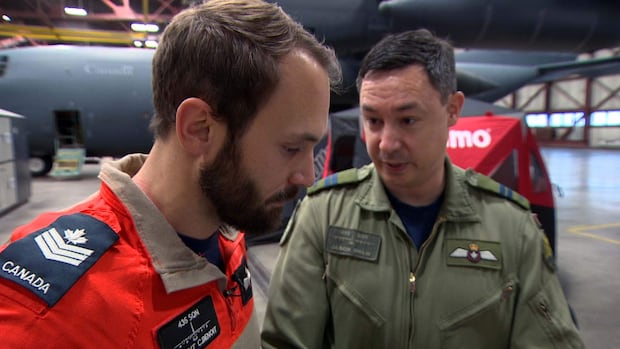Winnipeg military team parachuted into remote Northwest Territories to rescue plane crash survivors
10 people were rescued after Twin Otter plane went down 300 kilometres north of Yellowknife down on Dec. 27
A military search and rescue team from 17 Wing Winnipeg navigated through treacherous terrain and weather to save 10 people whose plane had crashed about 300 kilometres north of Yellowknife last week.
The Twin Otter plane operated by Air Tindi, a Yellowknife-based airline, was carrying eight passengers and two crew members when it went down on the afternoon of Dec. 27.
The search and rescue team was dispatched that night on a Royal Canadian Air Force CC-130 Hercules.
Hercules aircraft commander Capt. Jason Shaw said the team was able to find the crash site using satellite tracking.
But the low visibility and strong winds that evening made it difficult to get into position so that rescuers could parachute to the site, Shaw said.
"It looked like the clouds were coming up a little bit and we might have a small window to make that happen," he said in an interview with CBC on Friday. "So we took all the information we had at that time [and] made the decision to deploy them as soon as we could."
Finding the passengers
Sgt. Vincent C-Benoit was among three search and rescue technicians who parachuted in from an altitude of 2,000 feet (just over 600 metres) with medical supplies, food and survival gear in the cold, dark night.
Once on the ground, they found six passengers who had taken shelter in a tent that was part of the plane's survival gear, Benoit said. Four others were still inside the downed aircraft.
"They did their own survival shelter, but it was quite exposed with the wind," he said.
The team treated the four passengers who were stuck inside the plane while setting up heated tents close to the wreckage to help protect the six other passengers from the elements.

Benoit said the team also had help from members of an emergency response team from the nearby Diavik diamond mine, who headed to the crash site on snowmobiles.
"It was quite the trouble for them at night and in the blizzard, but they were able to come and help and I was really happy to see them," said Benoit.
The crash happened about 16 kilometres southeast of the Diavik diamond mine, but the privately chartered flight wasn't carrying passengers to or from the camp, Air Tindi's president previously said.
Making it through the night
Even after the rescuers arrived, it still took several hours for everyone who was on the plane to be evacuated from the crash site.
Benoit said he was honest with the passengers, telling them they wouldn't be picked up until the morning.
"My first thing I told him is, 'You're not out of the woods yet and there's help, there's extraction coming, but it won't be until the morning, so you gotta stay in the fight,'" he said.

Despite the dire circumstances, morale was quite good throughout the night, Benoit said.
"Even though they were in a dire situation, they're all good people," he said.
"We exchanged the meal, exchanged a few stories and we're quite pleased to be together in that situation."
The following morning, the passengers were rescued with the help of a helicopter.
A spokesperson for 1 Canadian Air Division and Canadian NORAD Region Headquarters said all 10 people had been safely extracted and taken to the Diavik mine by 1 p.m. MT on Dec. 28.
The 10 passengers and crew were flown into Yellowknife later that afternoon and taken to hospital for medical assessments, Air Tindi president Chris Reynolds said last week.
Six of the people were assessed as having minor injuries, while two had moderate to serious injuries but were expected to recover.
Benoit said he's rescued passengers from plane crashes before, but nothing as intense as this.

"[It] takes years of experience to be able to conduct something like this," he said.
"I would say everybody's proud, everybody's happy that those 10 passengers were able to get out of there alive."
A preliminary report from the Transportation Safety Board determined the plane, which was fitted with skis, was travelling from Margaret Lake to Lac de Gras in the Northwest Territories when it crashed as it was attempting to land on the lake.
The president for Air Tindi previously said it was cold and windy at the crash site, which hampered an immediate rescue.

With files from CBC's Josh Crabb and The Canadian Press



